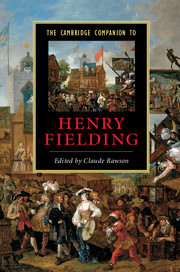Book contents
- Frontmatter
- Introduction
- 1 Henry Fielding’s life
- 2 Fielding’s theatrical career
- 3 Shamela
- 4 Joseph Andrews
- 5 Jonathan Wild
- 6 Tom Jones
- 7 Amelia
- 8 Fielding’s periodical journalism
- 9 Fielding and female authority
- 10 Fielding on society, crime, and the law
- 11 Fielding’s style
- 12 Fielding’s afterlife
- Guide to further reading
- Index
- Series List
7 - Amelia
Published online by Cambridge University Press: 28 July 2007
- Frontmatter
- Introduction
- 1 Henry Fielding’s life
- 2 Fielding’s theatrical career
- 3 Shamela
- 4 Joseph Andrews
- 5 Jonathan Wild
- 6 Tom Jones
- 7 Amelia
- 8 Fielding’s periodical journalism
- 9 Fielding and female authority
- 10 Fielding on society, crime, and the law
- 11 Fielding’s style
- 12 Fielding’s afterlife
- Guide to further reading
- Index
- Series List
Summary
In December 1751, when Amelia was first published, Fielding was at the height of his fame, both as the energetic and conscientious Bow Street magistrate for Westminster and Middlesex and as a novelist whose only equal was his great rival, Samuel Richardson. His previous novel, Tom Jones, published in February 1749, two months after the final instalment of Richardson’s Clarissa, had gone through four authorized editions within a year, running to a total of 10,000 copies, and, despite some hostile criticism, had been generally acclaimed. There were Dublin reprints, translations into Dutch, French, and German, and (as with Richardson’s best-seller, Pamela, ten years earlier), exploitative spin-offs by anonymous hacks, such as The History of Tom Jones, the Foundling, in his Married State (1749) and The History of Charlotte Summers, the Fortunate Parish Girl (1750). The new novel, which Fielding began writing in autumn 1749, was eagerly awaited. On 29 October 1751, Walter Harte in Bath informed his friend Sir Charles Hanbury Williams in Dresden that 'Fielding is coming out with another work, in the tone and style of his late performances.' Shortly afterwards, on 2 December 1751, Fielding’s publisher Andrew Millar placed an advertisement for Amelia in The General Advertiser, designed to increase interest in the forthcoming novel still further: ’to satisfy the earnest Demand of the Publick, this Work is now printing at four Presses; but the Proprietor notwithstanding finds it impossible to get them bound in Time without spoiling the Beauty of the Impression, and therefore will sell them sew'd at Half a Guinea a Sett.'
- Type
- Chapter
- Information
- The Cambridge Companion to Henry Fielding , pp. 94 - 108Publisher: Cambridge University PressPrint publication year: 2007
- 1
- Cited by

